Ruofan Liang
LuxDiT: Lighting Estimation with Video Diffusion Transformer
Sep 03, 2025Abstract:Estimating scene lighting from a single image or video remains a longstanding challenge in computer vision and graphics. Learning-based approaches are constrained by the scarcity of ground-truth HDR environment maps, which are expensive to capture and limited in diversity. While recent generative models offer strong priors for image synthesis, lighting estimation remains difficult due to its reliance on indirect visual cues, the need to infer global (non-local) context, and the recovery of high-dynamic-range outputs. We propose LuxDiT, a novel data-driven approach that fine-tunes a video diffusion transformer to generate HDR environment maps conditioned on visual input. Trained on a large synthetic dataset with diverse lighting conditions, our model learns to infer illumination from indirect visual cues and generalizes effectively to real-world scenes. To improve semantic alignment between the input and the predicted environment map, we introduce a low-rank adaptation finetuning strategy using a collected dataset of HDR panoramas. Our method produces accurate lighting predictions with realistic angular high-frequency details, outperforming existing state-of-the-art techniques in both quantitative and qualitative evaluations.
ContraGS: Codebook-Condensed and Trainable Gaussian Splatting for Fast, Memory-Efficient Reconstruction
Sep 03, 2025Abstract:3D Gaussian Splatting (3DGS) is a state-of-art technique to model real-world scenes with high quality and real-time rendering. Typically, a higher quality representation can be achieved by using a large number of 3D Gaussians. However, using large 3D Gaussian counts significantly increases the GPU device memory for storing model parameters. A large model thus requires powerful GPUs with high memory capacities for training and has slower training/rendering latencies due to the inefficiencies of memory access and data movement. In this work, we introduce ContraGS, a method to enable training directly on compressed 3DGS representations without reducing the Gaussian Counts, and thus with a little loss in model quality. ContraGS leverages codebooks to compactly store a set of Gaussian parameter vectors throughout the training process, thereby significantly reducing memory consumption. While codebooks have been demonstrated to be highly effective at compressing fully trained 3DGS models, directly training using codebook representations is an unsolved challenge. ContraGS solves the problem of learning non-differentiable parameters in codebook-compressed representations by posing parameter estimation as a Bayesian inference problem. To this end, ContraGS provides a framework that effectively uses MCMC sampling to sample over a posterior distribution of these compressed representations. With ContraGS, we demonstrate that ContraGS significantly reduces the peak memory during training (on average 3.49X) and accelerated training and rendering (1.36X and 1.88X on average, respectively), while retraining close to state-of-art quality.
UniRelight: Learning Joint Decomposition and Synthesis for Video Relighting
Jun 18, 2025Abstract:We address the challenge of relighting a single image or video, a task that demands precise scene intrinsic understanding and high-quality light transport synthesis. Existing end-to-end relighting models are often limited by the scarcity of paired multi-illumination data, restricting their ability to generalize across diverse scenes. Conversely, two-stage pipelines that combine inverse and forward rendering can mitigate data requirements but are susceptible to error accumulation and often fail to produce realistic outputs under complex lighting conditions or with sophisticated materials. In this work, we introduce a general-purpose approach that jointly estimates albedo and synthesizes relit outputs in a single pass, harnessing the generative capabilities of video diffusion models. This joint formulation enhances implicit scene comprehension and facilitates the creation of realistic lighting effects and intricate material interactions, such as shadows, reflections, and transparency. Trained on synthetic multi-illumination data and extensive automatically labeled real-world videos, our model demonstrates strong generalization across diverse domains and surpasses previous methods in both visual fidelity and temporal consistency.
VideoMat: Extracting PBR Materials from Video Diffusion Models
Jun 11, 2025Abstract:We leverage finetuned video diffusion models, intrinsic decomposition of videos, and physically-based differentiable rendering to generate high quality materials for 3D models given a text prompt or a single image. We condition a video diffusion model to respect the input geometry and lighting condition. This model produces multiple views of a given 3D model with coherent material properties. Secondly, we use a recent model to extract intrinsics (base color, roughness, metallic) from the generated video. Finally, we use the intrinsics alongside the generated video in a differentiable path tracer to robustly extract PBR materials directly compatible with common content creation tools.
Controllable Weather Synthesis and Removal with Video Diffusion Models
May 01, 2025Abstract:Generating realistic and controllable weather effects in videos is valuable for many applications. Physics-based weather simulation requires precise reconstructions that are hard to scale to in-the-wild videos, while current video editing often lacks realism and control. In this work, we introduce WeatherWeaver, a video diffusion model that synthesizes diverse weather effects -- including rain, snow, fog, and clouds -- directly into any input video without the need for 3D modeling. Our model provides precise control over weather effect intensity and supports blending various weather types, ensuring both realism and adaptability. To overcome the scarcity of paired training data, we propose a novel data strategy combining synthetic videos, generative image editing, and auto-labeled real-world videos. Extensive evaluations show that our method outperforms state-of-the-art methods in weather simulation and removal, providing high-quality, physically plausible, and scene-identity-preserving results over various real-world videos.
DiffusionRenderer: Neural Inverse and Forward Rendering with Video Diffusion Models
Jan 30, 2025



Abstract:Understanding and modeling lighting effects are fundamental tasks in computer vision and graphics. Classic physically-based rendering (PBR) accurately simulates the light transport, but relies on precise scene representations--explicit 3D geometry, high-quality material properties, and lighting conditions--that are often impractical to obtain in real-world scenarios. Therefore, we introduce DiffusionRenderer, a neural approach that addresses the dual problem of inverse and forward rendering within a holistic framework. Leveraging powerful video diffusion model priors, the inverse rendering model accurately estimates G-buffers from real-world videos, providing an interface for image editing tasks, and training data for the rendering model. Conversely, our rendering model generates photorealistic images from G-buffers without explicit light transport simulation. Experiments demonstrate that DiffusionRenderer effectively approximates inverse and forwards rendering, consistently outperforming the state-of-the-art. Our model enables practical applications from a single video input--including relighting, material editing, and realistic object insertion.
INRet: A General Framework for Accurate Retrieval of INRs for Shapes
Jan 27, 2025



Abstract:Implicit neural representations (INRs) have become an important method for encoding various data types, such as 3D objects or scenes, images, and videos. They have proven to be particularly effective at representing 3D content, e.g., 3D scene reconstruction from 2D images, novel 3D content creation, as well as the representation, interpolation, and completion of 3D shapes. With the widespread generation of 3D data in an INR format, there is a need to support effective organization and retrieval of INRs saved in a data store. A key aspect of retrieval and clustering of INRs in a data store is the formulation of similarity between INRs that would, for example, enable retrieval of similar INRs using a query INR. In this work, we propose INRet, a method for determining similarity between INRs that represent shapes, thus enabling accurate retrieval of similar shape INRs from an INR data store. INRet flexibly supports different INR architectures such as INRs with octree grids, triplanes, and hash grids, as well as different implicit functions including signed/unsigned distance function and occupancy field. We demonstrate that our method is more general and accurate than the existing INR retrieval method, which only supports simple MLP INRs and requires the same architecture between the query and stored INRs. Furthermore, compared to converting INRs to other representations (e.g., point clouds or multi-view images) for 3D shape retrieval, INRet achieves higher accuracy while avoiding the conversion overhead.
Photorealistic Object Insertion with Diffusion-Guided Inverse Rendering
Aug 19, 2024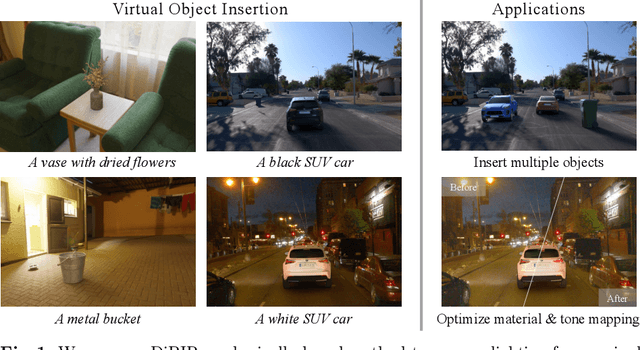

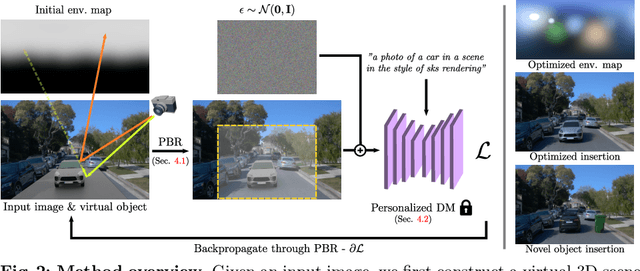

Abstract:The correct insertion of virtual objects in images of real-world scenes requires a deep understanding of the scene's lighting, geometry and materials, as well as the image formation process. While recent large-scale diffusion models have shown strong generative and inpainting capabilities, we find that current models do not sufficiently "understand" the scene shown in a single picture to generate consistent lighting effects (shadows, bright reflections, etc.) while preserving the identity and details of the composited object. We propose using a personalized large diffusion model as guidance to a physically based inverse rendering process. Our method recovers scene lighting and tone-mapping parameters, allowing the photorealistic composition of arbitrary virtual objects in single frames or videos of indoor or outdoor scenes. Our physically based pipeline further enables automatic materials and tone-mapping refinement.
DISORF: A Distributed Online NeRF Training and Rendering Framework for Mobile Robots
Mar 01, 2024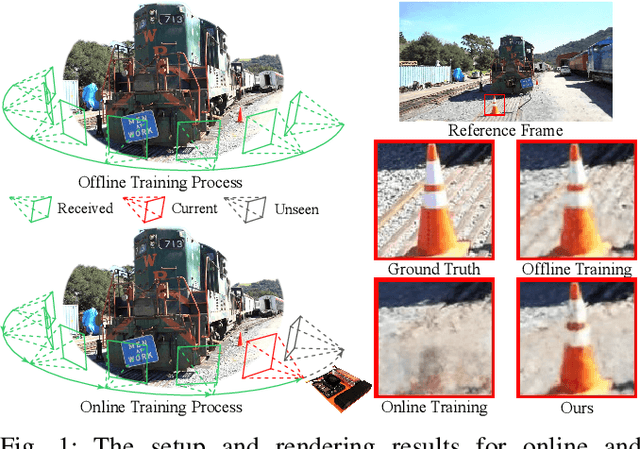

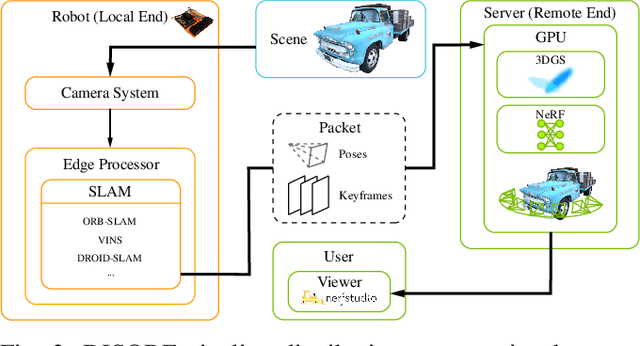
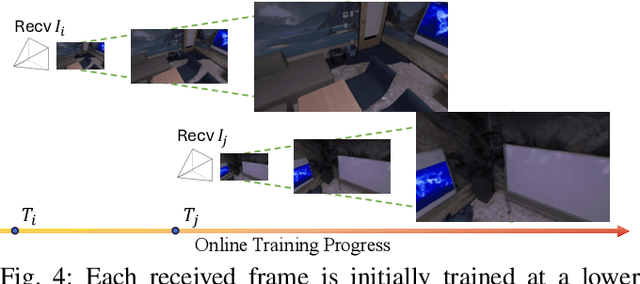
Abstract:We present a framework, DISORF, to enable online 3D reconstruction and visualization of scenes captured by resource-constrained mobile robots and edge devices. To address the limited compute capabilities of edge devices and potentially limited network availability, we design a framework that efficiently distributes computation between the edge device and remote server. We leverage on-device SLAM systems to generate posed keyframes and transmit them to remote servers that can perform high quality 3D reconstruction and visualization at runtime by leveraging NeRF models. We identify a key challenge with online NeRF training where naive image sampling strategies can lead to significant degradation in rendering quality. We propose a novel shifted exponential frame sampling method that addresses this challenge for online NeRF training. We demonstrate the effectiveness of our framework in enabling high-quality real-time reconstruction and visualization of unknown scenes as they are captured and streamed from cameras in mobile robots and edge devices.
GaussianObject: Just Taking Four Images to Get A High-Quality 3D Object with Gaussian Splatting
Feb 20, 2024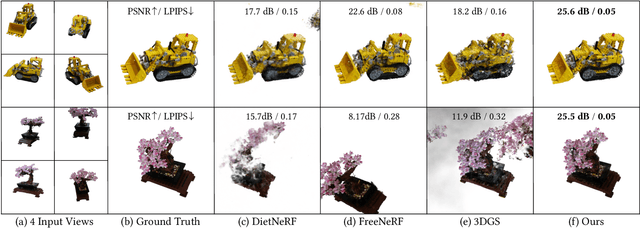
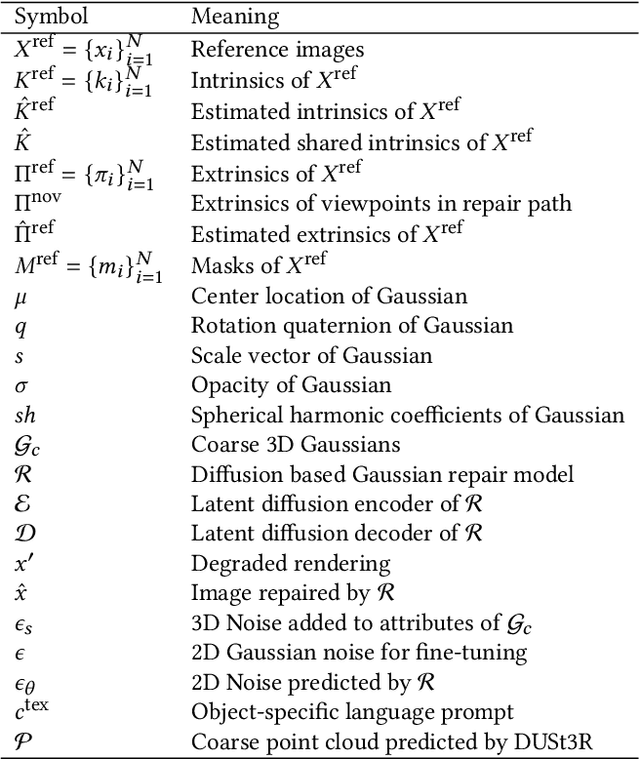

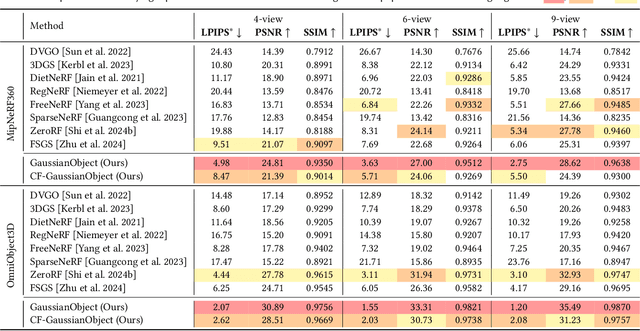
Abstract:Reconstructing and rendering 3D objects from highly sparse views is of critical importance for promoting applications of 3D vision techniques and improving user experience. However, images from sparse views only contain very limited 3D information, leading to two significant challenges: 1) Difficulty in building multi-view consistency as images for matching are too few; 2) Partially omitted or highly compressed object information as view coverage is insufficient. To tackle these challenges, we propose GaussianObject, a framework to represent and render the 3D object with Gaussian splatting, that achieves high rendering quality with only 4 input images. We first introduce techniques of visual hull and floater elimination which explicitly inject structure priors into the initial optimization process for helping build multi-view consistency, yielding a coarse 3D Gaussian representation. Then we construct a Gaussian repair model based on diffusion models to supplement the omitted object information, where Gaussians are further refined. We design a self-generating strategy to obtain image pairs for training the repair model. Our GaussianObject is evaluated on several challenging datasets, including MipNeRF360, OmniObject3D, and OpenIllumination, achieving strong reconstruction results from only 4 views and significantly outperforming previous state-of-the-art methods.
 Add to Chrome
Add to Chrome Add to Firefox
Add to Firefox Add to Edge
Add to Edge